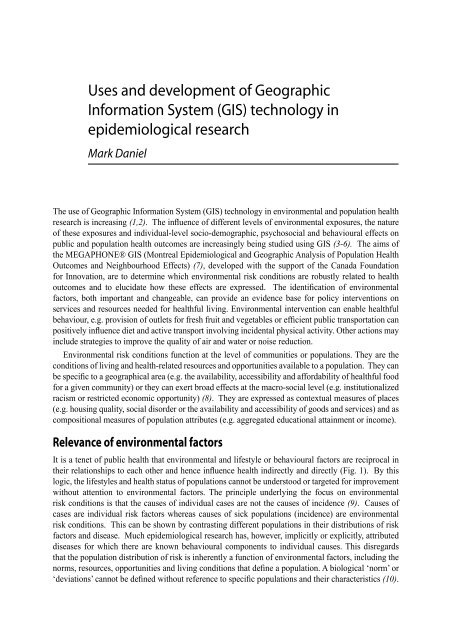South-East Asia Regional Conference on Epidemiology
South-East Asia Regional Conference on Epidemiology
South-East Asia Regional Conference on Epidemiology
Create successful ePaper yourself
Turn your PDF publications into a flip-book with our unique Google optimized e-Paper software.
Uses and development of Geographic<br />
Informati<strong>on</strong> System (GIS) technology in<br />
epidemiological research<br />
Mark Daniel<br />
The use of Geographic Informati<strong>on</strong> System (GIS) technology in envir<strong>on</strong>mental and populati<strong>on</strong> health<br />
research is increasing (1,2). The influence of different levels of envir<strong>on</strong>mental exposures, the nature<br />
of these exposures and individual-level socio-demographic, psychosocial and behavioural effects <strong>on</strong><br />
public and populati<strong>on</strong> health outcomes are increasingly being studied using GIS (3-6). The aims of<br />
the MEGAPHONE® GIS (M<strong>on</strong>treal Epidemiological and Geographic Analysis of Populati<strong>on</strong> Health<br />
Outcomes and Neighbourhood Effects) (7), developed with the support of the Canada Foundati<strong>on</strong><br />
for Innovati<strong>on</strong>, are to determine which envir<strong>on</strong>mental risk c<strong>on</strong>diti<strong>on</strong>s are robustly related to health<br />
outcomes and to elucidate how these effects are expressed. The identificati<strong>on</strong> of envir<strong>on</strong>mental<br />
factors, both important and changeable, can provide an evidence base for policy interventi<strong>on</strong>s <strong>on</strong><br />
services and resources needed for healthful living. Envir<strong>on</strong>mental interventi<strong>on</strong> can enable healthful<br />
behaviour, e.g. provisi<strong>on</strong> of outlets for fresh fruit and vegetables or efficient public transportati<strong>on</strong> can<br />
positively influence diet and active transport involving incidental physical activity. Other acti<strong>on</strong>s may<br />
include strategies to improve the quality of air and water or noise reducti<strong>on</strong>.<br />
Envir<strong>on</strong>mental risk c<strong>on</strong>diti<strong>on</strong>s functi<strong>on</strong> at the level of communities or populati<strong>on</strong>s. They are the<br />
c<strong>on</strong>diti<strong>on</strong>s of living and health-related resources and opportunities available to a populati<strong>on</strong>. They can<br />
be specific to a geographical area (e.g. the availability, accessibility and affordability of healthful food<br />
for a given community) or they can exert broad effects at the macro-social level (e.g. instituti<strong>on</strong>alized<br />
racism or restricted ec<strong>on</strong>omic opportunity) (8). They are expressed as c<strong>on</strong>textual measures of places<br />
(e.g. housing quality, social disorder or the availability and accessibility of goods and services) and as<br />
compositi<strong>on</strong>al measures of populati<strong>on</strong> attributes (e.g. aggregated educati<strong>on</strong>al attainment or income).<br />
Relevance of envir<strong>on</strong>mental factors<br />
It is a tenet of public health that envir<strong>on</strong>mental and lifestyle or behavioural factors are reciprocal in<br />
their relati<strong>on</strong>ships to each other and hence influence health indirectly and directly (Fig. 1). By this<br />
logic, the lifestyles and health status of populati<strong>on</strong>s cannot be understood or targeted for improvement<br />
without attenti<strong>on</strong> to envir<strong>on</strong>mental factors. The principle underlying the focus <strong>on</strong> envir<strong>on</strong>mental<br />
risk c<strong>on</strong>diti<strong>on</strong>s is that the causes of individual cases are not the causes of incidence (9). Causes of<br />
cases are individual risk factors whereas causes of sick populati<strong>on</strong>s (incidence) are envir<strong>on</strong>mental<br />
risk c<strong>on</strong>diti<strong>on</strong>s. This can be shown by c<strong>on</strong>trasting different populati<strong>on</strong>s in their distributi<strong>on</strong>s of risk<br />
factors and disease. Much epidemiological research has, however, implicitly or explicitly, attributed<br />
diseases for which there are known behavioural comp<strong>on</strong>ents to individual causes. This disregards<br />
that the populati<strong>on</strong> distributi<strong>on</strong> of risk is inherently a functi<strong>on</strong> of envir<strong>on</strong>mental factors, including the<br />
norms, resources, opportunities and living c<strong>on</strong>diti<strong>on</strong>s that define a populati<strong>on</strong>. A biological ‘norm’ or<br />
‘deviati<strong>on</strong>s’ cannot be defined without reference to specific populati<strong>on</strong>s and their characteristics (10).









